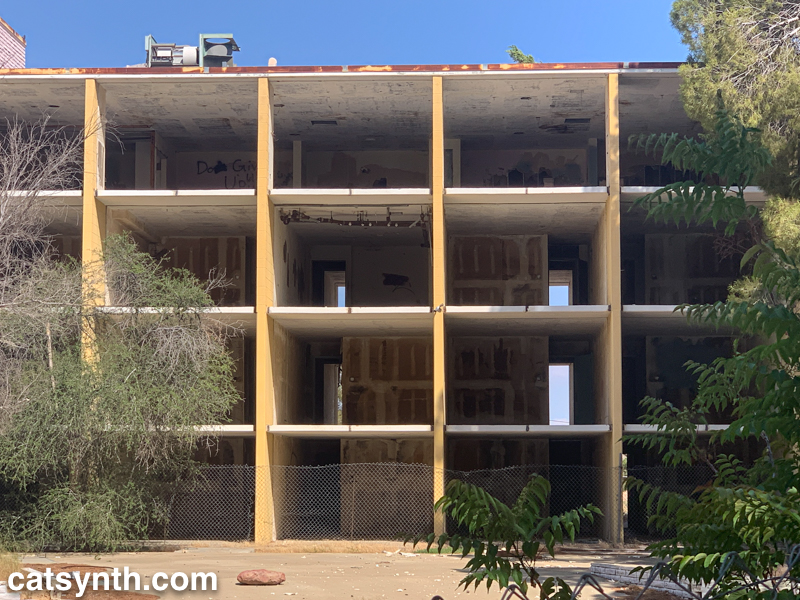
An unfinished apartment building in California City.

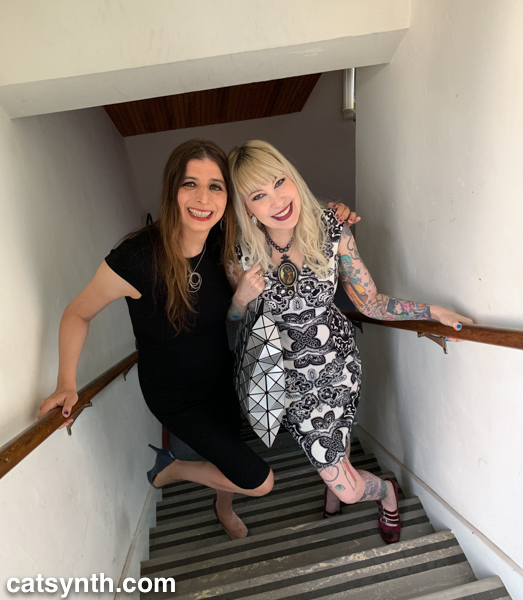
Posing with my friend and collaborator Serena Toxicat at the Outsound benefit dinner a couple of weeks ago. Although about the same height, size, and silhouette, our color and texture were true contrasts. Black vs white, solid vs patterned. Yin and yang.
You can see our video from the performance at the benefit dinner below.

For Father’s Day, we have some “patrilineal” art to share. This assemblage was created by my dad, combining a painting of his with a handkerchief that belonged to my grandfather. The material of the handkerchief is decades old and decaying, and the tears and texture make for a very interesting blend with the colors and shapes of the painting below.
We at CatSynth wish a happy Father’s Day to all the human and feline dads out there.
The second of our remembrances focuses on the architect I.M. Pei, who passed away this week. A true champion of modernism worldwide, I have admired his work both from afar and close up.
Perhaps the most vivid memory with his work was from the Suzhou Museum in Suzhou, China. It may not be his best known work, but it is a masterpiece in itself and a love letter to his hometown.
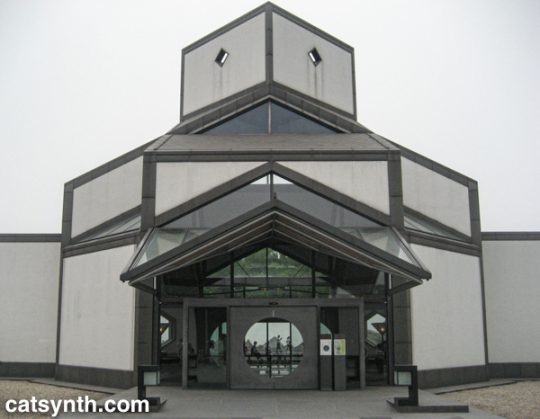
The exterior facade combines Pei’s trademark geometry and minimalism with more the more traditional designs and tropes of an adjacent palace and Suzhou’s famous gardens. It also makes extensive use of water as an architectural element both inside and outside the building.
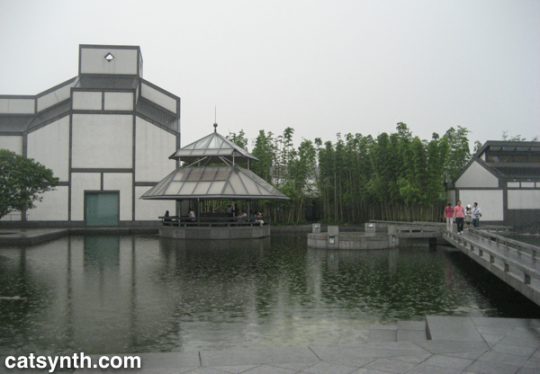
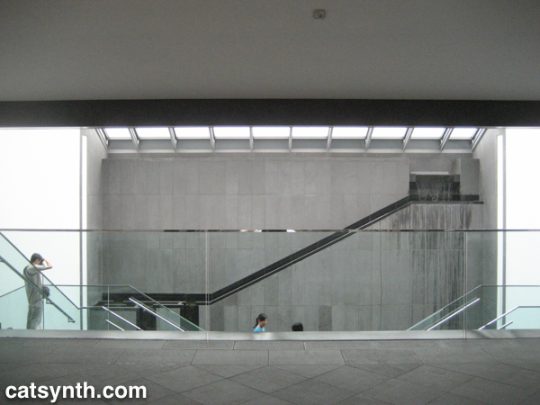
The simple geometric shapes, as well as the use of water, stone, and glass, gave the entire complex a very warm and welcoming feeling, even as the rain came down around me. Inside, the simplicity of the galleries left ample mental space to enjoy the exhibits and artifacts, while the atrium was a work of art itself.
I admire the way he often brought modernist aesthetics and principles to traditional spaces. This is perhaps most dramatically seen in his glass pyramid that anchors the Louvre Museum in Paris.
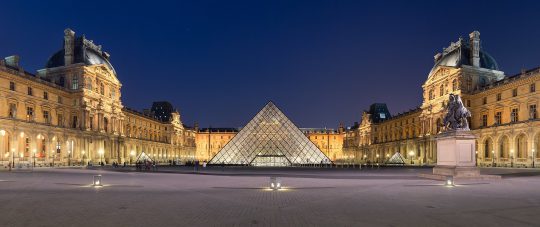
The pyramid is perfect, a stark contrast to the severe facades around it, and perfectly balanced in size and space. While I know many traditionalists have hated on this addition over the years, I for one love it. I am an unapologetic modernist and often find myself sparring with traditionalists even here in San Francisco.
Pei’s modernism was intended to integrate with its surroundings, even as it stood in contrast to it. For example, he wanted his stark geometric design for the Mesa Laboratory at the National Center for Atmospheric Research (U.S.A.) to look “as if it were carved out of the mountain”.
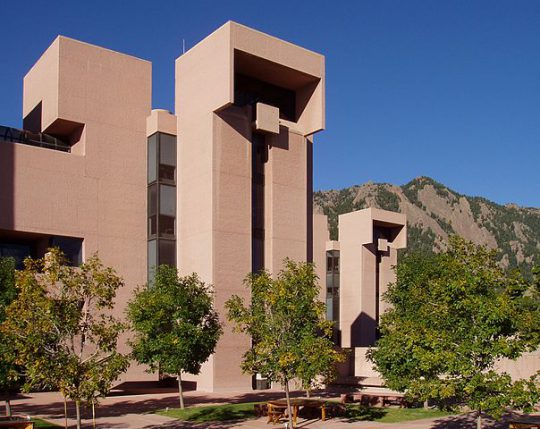
Until reading others’ tributes and remembrances, I had forgotten about his role in the Javits Center in New York, a building I am quite familiar with both inside and out. It is a massive and imposing structure but crisscrossed with triangular details that remind me of the Suzhou Museum (built 20 years later). The project was plagued by challenges and controversies, and “during the inauguration ceremonies, however, neither [James] Freed nor Pei was recognized for their role in the project.” [source]
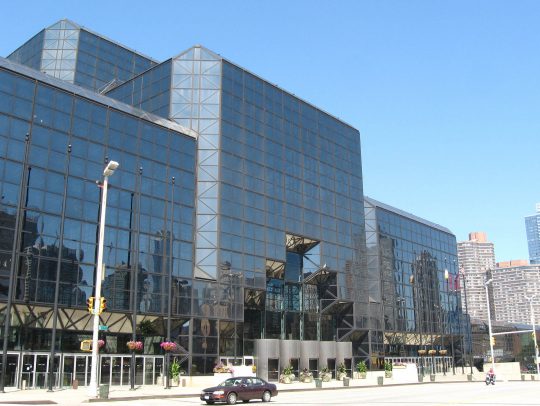
Triangles do seem to be a major recurring theme in his work, and perhaps part of why it appeals to me even within the scope of other modernists. Triangles are powerful and strong, and the often stand out in Western spaces dominated by rectangles. These elements also played a role East Building for the National Gallery in Washington, D.C., a project is loved by many, but similar to the Louvre, criticized by some traditionalists.
The building is a masterpiece of minimalism. Even some of those traditionalist critics have grown to love it in the years since it opened in 1978. And it serves its purpose, both as a home to art and a work of art itself.
The growing popularity of art museums presented unique challenges to the architecture. Mellon and Pei both expected large crowds of people to visit the new building, and they planned accordingly. To this end, he designed a large lobby roofed with enormous skylights. Individual galleries are located along the periphery, allowing visitors to return after viewing each exhibit to the spacious main room. A large mobile sculpture by American artist Alexander Calder was later added to the lobby.[93] Pei hoped the lobby would be exciting to the public in the same way as the central room of the Guggenheim Museum in New York. The modern museum, he said later, “must pay greater attention to its educational responsibility, especially to the young.”[94]
https://en.wikipedia.org/wiki/I._M._Pei#National_Gallery_East_Building,_Washington,_DC
Defending modernism, even after a century, remains a tireless job. As we lose champions like I.M. Pei, it falls to those of us in later generations to make sure this beauty is preserved and celebrated.

Today we look back at Théâtre National de Bretagne’s unusual production of Shakespeare’s Julius Caesar. We at CatSynth had the opportunity to see it at Zellerbach Hall in Berkeley, California a couple of weeks ago.
It is a play we know well, having read the original and recently revisited Joseph L. Mankiewicz’s epic 1953 film version starring Marlon Brando, James Mason, and John Gielgud. In contrast to that version which places the play in a grand realization of ancient Rome with large sets and hundreds of extras, this production directed by Arthur Nauzyciel with set design Scott Zielinski, was abstract and spare: a mostly empty stage surrounded by a backdrop of empty theater seats. The cast was stripped down to a small set of players, some pulling multiple roles – both Portia and Calpurnia were played by Sara Kathryn Bakker, for example. Their costumes (by James Schuette) were inspired by the 1960s, as were the furniture. We see the characters as mostly upper-class individuals in suits and dresses in spare rooms with modernist furniture, something directly out of Mad Men. We first see Brutus (James Waterson), Cassius (Mark Montgomery), and Julius Caesar (Dylan Kyussman) in simple tuxedos, with Mark Antony (Daniel Pettrow) bounding in wearing an Adidas tracksuit – a nice touch that harkened back to Brando’s jockish first scene as Antony in the 1953 film. One cannot consider these things anachronistic, seeing as how the Shakespeare play in itself is an anachronism, with its mentioning of clocks, doublets, etc., not to leave out the fact that it was written and generally performed in English. The drama is what is most important in the play, the interaction of the characters, and the mechanics of politics and public opinion.
Theatre is fundamentally about illusion and representation. Sometimes, perhaps most of the time, in older forms of theatre, minimalism accentuates the essence of what a dramatic piece is trying to convey. All of the information is conveyed through the words and actions, with the dressing secondary. As I believe it should be with Shakespeare. So I felt the right tone was taken with the way the visual aspect was handled.
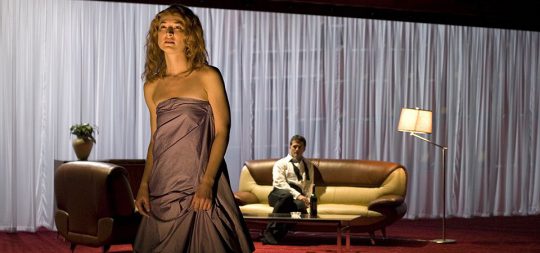
Of course, the central element of such a play is the acting and interpretation of the text. Kyussman’s portrayal of Caesar brought the right mixture of pomp and gravitas to his character. Waterson’s Brutus came across as conflicted in his feelings, ultimately choosing reason over loyalty. And Montgomery’s Cassius was a thoughtful but odd fellow. Bakker’s double-duty as Portia and Calpurnia was beautifully played but also served to highlight the overall lack of women characters in the play. Something I was ambivalent about was the decision to excise the scene with Cinna the Poet, and his being swept up by the angry mob and killed, having been confused with Cinna of the conspirators. This scene is excised from many stage productions and most films of the play, for purposes of pacing, which is unfortunate. I feel it is a crucial scene which shows the madness of crowds, the way opinio publica can be twisted by those who seek to further their own ends = “The abuse of greatness is when it disjoins remorse from power”, indeed.
The lighting was also a major player in this production. For most of the early scenes, the stage was shrouded in a mixture of darkness and low lighting. It is only when we get to the Capitol and the chamber of the Senate that the lights become bright, drawing us to a very stylized and choreographed assassination of Caesar. This continues into the speeches of Brutus and Antony before changing again into an eerie fog-filled atmosphere for the war scenes of the final act.
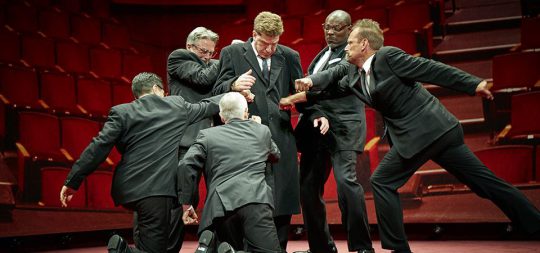
Perhaps the most unusual aspect of this production was the use of a live jazz trio, who performed between acts, and occasionally between scenes. The musicians (Marianne Solivan on vocals, Dmitry Ishenko on bass, and Leandro Pelligrino on guitar) were all top-notch and performed extremely well. But we were anticipating original music. What was presented was a selection of standards. In itself, this was not disappointing – and the joining in by Bakker as Portia and Montgomery as Cassius was fun. However, the selection of pieces – which, lyrically, commented upon the action with a winking, postmodern irony – in some ways undercut the otherwise serious and austere quality of the production and interpretation of the play. After the scene between Brutus and Portia, we were given “You’ve Changed”. In the entr’acte, we heard “Is That All There Is?” I felt by the end of the performance, it had become something close to a parody.
This sense that the music played against the other dimensions was highlighted in the final song-and-dance number, set to some recently recorded, faceless, autotuned pop song (I’m pretty sure it was a Lady Gaga song, but I can’t confirm). It really seemed to be negating much of what I feel is at the core of this play, very serious ideas about morality, duty, and civic responsibility.
This may be the director’s intention, I don’t know for sure, and I can’t say. The director took many chances with the production and created a fairly unique take on a work which has been performed so many times, in different ways. “How many ages hence shall this, our lofty scene, be acted over in states unborn and accents yet unknown”, indeed.
Overall we enjoyed the performance, the design, and the acting. And I like to see productions of Shakespeare’s plays take chances with new directions rather than simply redoing the same thing over and over again. But with any experiment, sometimes things work and sometimes things do not. The end result here was mixed and ambiguous. But perhaps that was the point.
[Jason Berry contributed to this review.]

Sculpture at Fleishmann Pier in Peekskill, NY. We see the Hudson River and the Bear Mountain Bridge in the distance.
Last week’s Wordless Wednesday was also taken in Westchester County along the Hudson River.
We at CatSynth have been fascinated with the Codex Seraphinianus long before this beautiful edition made its way to CatSynth HQ.
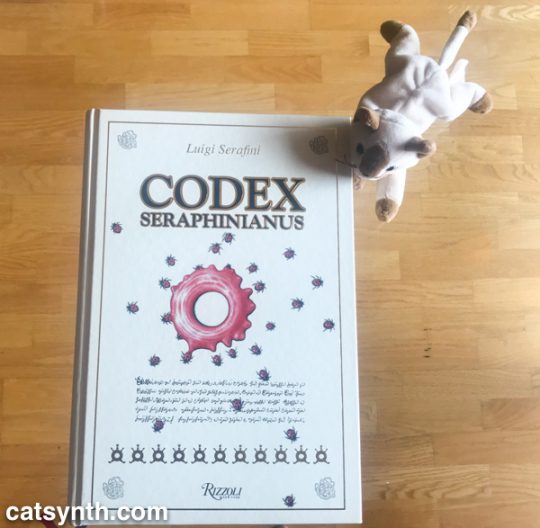
The Codex is a masterpiece of book art by Italian artist, architect
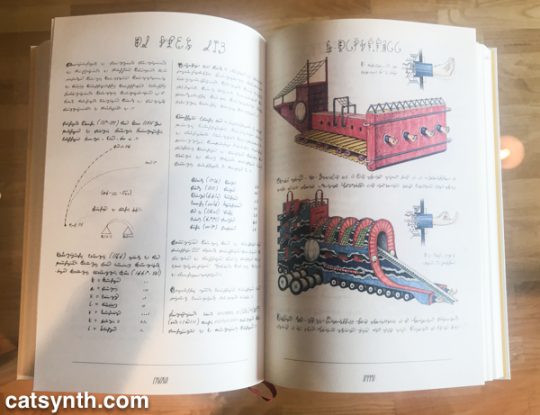
Most interesting of all, it is written in a completely invented script.

The script, consisting of squiggles and dots, sometimes detached and sometimes cursive, resemble a Western, Semitic or South Asian script, but one entirely of Serafini’s own imagination. It is easy to pick out repeated letters, such as the “E-like” character with one dot in its lower section; and curve-on-a-stem that appears to serve as a singular character in many portions of the first book.

Even without knowing the full meaning of the script or the illustrations, one can start to discern meaning. For example, on this page it is pretty clear that this creature tends to wilt (perhaps even suffer) in rain, but thrives in sunshine. (This is something I can sympathize with.)
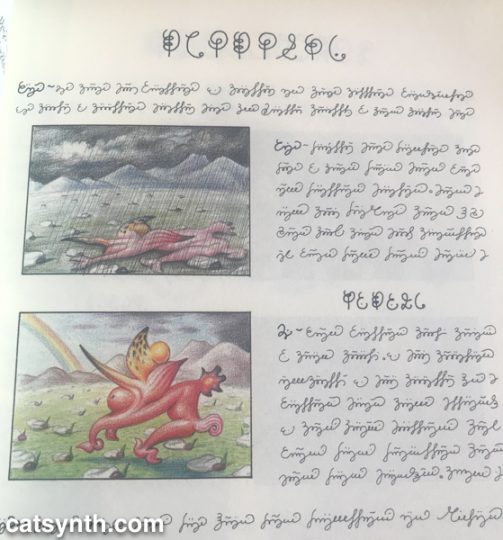
Serafini himself has declared the writing in the Codex to be asemic, without a specific structure or meaning. And while I take him at his word, one cannot help but construct meaning from both the images and the writing. I have long been fascinated by other alphabets and writing systems and been able to find patterns (and even learn them to some degree) independent of the languages they represent. For example, I was able to learn a bit of the Tamil script when traveling in South India in my youth, though I never learned the sounds or the language. Similarly, I began to pick up Sinographic characters in my time in China but with no knowledge of how to pronounce most of them.
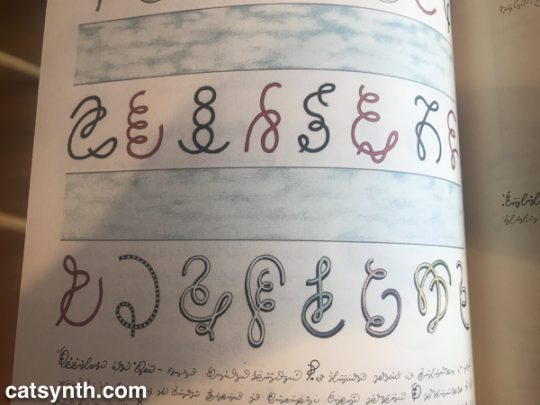
It is in this vein that I have begun to read the Codex from its start, treating it as a pure work of art with text and illustration as its medium. It’s actually a pleasurable and captivating experience to pour over the text and spot the patterns without being confined by the need for meaning. I made it through the first book (plants and anthropomorphic flora) and a bit into the second (animals). It is the fourth book (physics, chemistry) and the fifth (machines) that I most curious to “read” in depth, but I will take my time to get there.